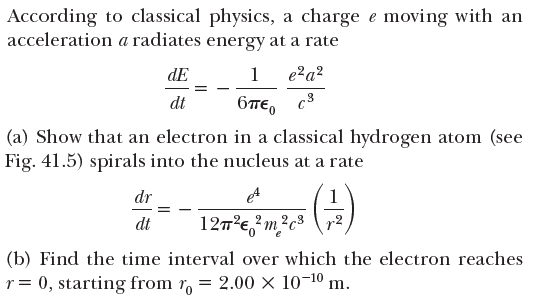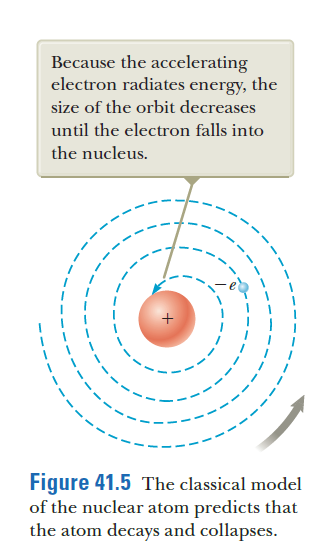According to classical physics, a charge e moving with an acceleration a radiates energy at a rate dE 1 e?a? dt 6TE, c3 (a) Show that an electron in a classical hydrogen atom (see Fig. 41.5) spirals into the nucleus at a rate dr 1 dt 127'e,?m?c³ r2 (b) Find the time interval over which the electron reaches r= 0, starting from r, = 2.00 × 10-10 m. Because the accelerating electron radiates energy, the size of the orbit decreases until the electron falls into the nucleus. Figure 41.5 The classical model of the nuclear atom predicts that the atom decays and collapses.
According to classical physics, a charge e moving with an acceleration a radiates energy at a rate dE 1 e?a? dt 6TE, c3 (a) Show that an electron in a classical hydrogen atom (see Fig. 41.5) spirals into the nucleus at a rate dr 1 dt 127'e,?m?c³ r2 (b) Find the time interval over which the electron reaches r= 0, starting from r, = 2.00 × 10-10 m. Because the accelerating electron radiates energy, the size of the orbit decreases until the electron falls into the nucleus. Figure 41.5 The classical model of the nuclear atom predicts that the atom decays and collapses.
Related questions
Question

Transcribed Image Text:According to classical physics, a charge e moving with an
acceleration a radiates energy at a rate
dE
1
e?a?
dt
6TE, c3
(a) Show that an electron in a classical hydrogen atom (see
Fig. 41.5) spirals into the nucleus at a rate
dr
1
dt
127'e,?m?c³
r2
(b) Find the time interval over which the electron reaches
r= 0, starting from r, = 2.00 × 10-10 m.

Transcribed Image Text:Because the accelerating
electron radiates energy, the
size of the orbit decreases
until the electron falls into
the nucleus.
Figure 41.5 The classical model
of the nuclear atom predicts that
the atom decays and collapses.
Expert Solution
This question has been solved!
Explore an expertly crafted, step-by-step solution for a thorough understanding of key concepts.
This is a popular solution!
Trending now
This is a popular solution!
Step by step
Solved in 4 steps with 4 images
